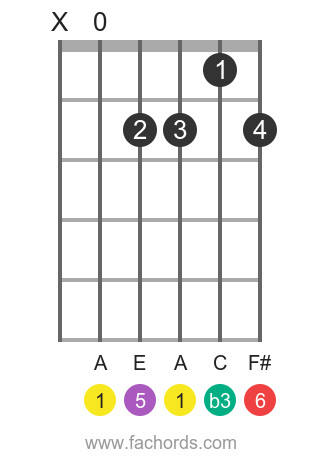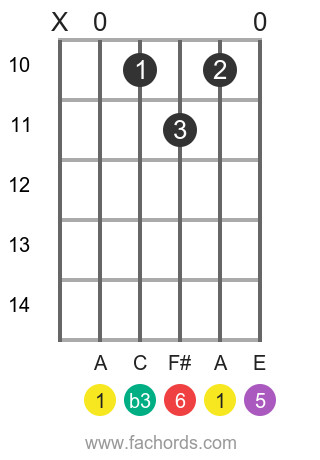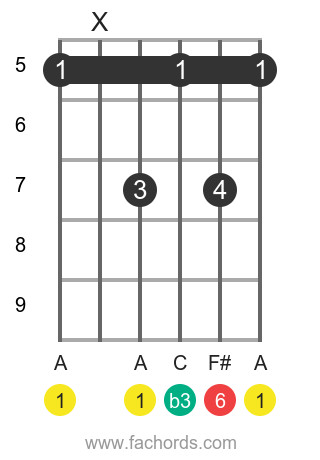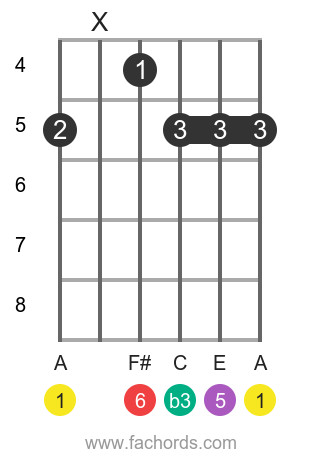The Am6 Guitar Chord, a member of the Minor Chords family, offers a rich and sophisticated sound that can elevate your guitar playing. Built from the notes A, C, E, and F#, the Am6 chord utilizes the 1, b3, 5, and 6 intervals – Root, Minor Third, Perfect Fifth, and Major Sixth respectively. This unique combination creates a melancholic yet intriguing flavor, distinct from simpler minor chords.
If you’re just getting acquainted with sixth chords, exploring our dedicated guide to sixth guitar chords will provide a deeper understanding of this chord family. Understanding chord construction through intervals is key to unlocking the fretboard. For those eager to delve into music theory, our tutorials on fretboard intervals and building chords by stacking intervals are invaluable resources.
In this lesson, we’ll provide comprehensive chord diagrams and fretboard patterns for the Am6 chord, visually illustrating the notes and their positions. These visual aids are powerful tools for learning and internalizing the chord’s structure. If you need a refresher on reading chord diagrams, our tutorial on chord notation is available to assist you.
Whether you’re an intermediate guitarist seeking to enrich your chord palette or a beginner embracing new challenges, the Am6 chord is a rewarding addition to your repertoire. Let’s explore how to play and utilize this beautiful chord.
Decoding the Am6 Chord: Notes and Structure
The Am6 chord is composed of four distinct notes:
- A – Root (1)
- C – Minor Third (b3)
- E – Perfect Fifth (5)
- F# – Major Sixth (6)
These intervals, when stacked together, create the characteristic sound of the minor sixth chord.
Understanding the chord structure in terms of intervals provides a framework for building and recognizing minor sixth chords in any key. The structure is as follows:
| Interval | Note in Am6 |
|---|---|
| 1 (Root) | A |
| b3 (Minor Third) | C |
| 5 (Perfect Fifth) | E |
| 6 (Major Sixth) | F# |
Playing the Am6 Chord: Chord Positions and Diagrams
Chord diagrams are your visual roadmap to playing chords on the guitar. They represent the guitar fretboard, allowing you to see exactly where to place your fingers. The following diagrams illustrate various positions for playing the Am6 chord, ordered from easier to more challenging. If barre chords present a challenge, our Bar Chords Tips tutorial offers helpful guidance. For a text-based representation of these diagrams, you can also visit our accessible chords page.
Position 1: Open Position Am6
This is a common and relatively accessible voicing for the Am6 chord.
 Am6 Open Position Guitar Chord Diagram
Am6 Open Position Guitar Chord Diagram
This open position voicing of Am6 utilizes open strings and is a great starting point for beginners. Focus on ensuring each string rings clearly.
Position 2: Another Open Am6 Variation
This second open position offers a slightly different voicing and finger placement for the Am6 chord.
 Am6 Open Position Variation Guitar Chord Diagram
Am6 Open Position Variation Guitar Chord Diagram
Experiment with both open positions to find which feels more comfortable and which voicing you prefer in different musical contexts.
Position 3: Barre Chord Am6 (Movable Shape)
This barre chord shape allows you to play the Am6 chord up and down the neck by simply moving the entire shape.
 Am6 Barre Chord Position 3 Guitar Diagram
Am6 Barre Chord Position 3 Guitar Diagram
Mastering barre chords expands your ability to play chords in various positions on the fretboard. This movable shape is crucial for playing Am6 in different keys and registers.
Position 4: Higher Barre Chord Am6 (Movable Shape)
Another movable barre chord shape, this position offers a higher register voicing of the Am6 chord.
 Am6 Barre Chord Position 4 Guitar Diagram
Am6 Barre Chord Position 4 Guitar Diagram
This higher position is useful for creating different textures and melodic lines in your playing. Barre chords like this provide flexibility and control over chord voicings.
Explore our extensive guitar chords library for even more chord shapes. For a handy printable resource, download our Free Guitar Chords Chart Pdf.
Am6 Chord in Musical Context
The Am6 chord’s distinctive sound makes it a valuable tool in various musical genres. Its minor tonality combined with the major sixth interval creates a bittersweet, jazzy, and sometimes even cinematic feel.
Where to use the Am6 chord:
- Jazz: Am6 is frequently used in jazz progressions, adding a touch of sophistication and complexity.
- Pop and Ballads: It can introduce emotional depth and a slightly melancholic vibe to pop songs and ballads.
- Fingerstyle Guitar: The rich harmonic texture of Am6 makes it ideal for fingerstyle arrangements.
- Blues: While less common than dominant or 7th chords, Am6 can add a unique flavor to blues progressions.
Experiment with Am6 in chord progressions:
Try substituting the Am6 chord for a standard Am chord in a progression to hear the difference. You can also use it as a passing chord or in chord melodies to create interesting harmonic movement.
Expand Your Minor Sixth Chord Vocabulary
Once you’re comfortable with Am6, explore other minor sixth chords to further expand your sonic palette. Here are some common minor sixth chords to learn:
C m6 | D m6 | E m6 | F m6 | G m6 | A m6 | B m6 | C#m6 | D#m6 | F#m6 | G#m6 | A#m6 | Abm6 | Bbm6 | Dbm6 | Ebm6 | Gbm6
You can also create your own Am6 chord voicings across the fretboard by utilizing the chord tones: A (1), C (b3), E (5), and F# (6). The fretboard map below visualizes these tones across the neck.
[Fretboard map image as in the original article]
By understanding the notes and structure of the Am6 chord, and exploring its various positions and musical applications, you can add a touch of sophistication and depth to your guitar playing. Keep practicing and experimenting, and you’ll soon master the Am6 and unlock its musical potential!
